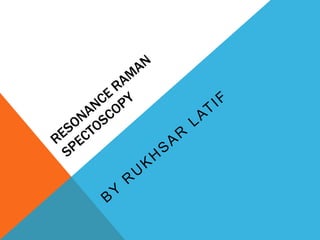
Raman Spectroscopy Techniques for Analyzing Molecular Vibrations
- 2. Raman spectroscopy was discovered by C. V. Raman in 1928 It is a spectroscopic technique used to observe vibration , rotational, and other low-frequency modes in a system.
- 3. Resonance Raman spectroscopy (RR spectroscopy) RAMAN technique in which the incident photon energy is close in energy to an electronic transitions of a compound or material under examination. The frequency coincidence (or resonance) can lead to greatly enhanced intensity of RAMAN scattering, which facilitates the study of chemical compounds present at low concentrations. Raman scattering is usually extremely weak, of the order of 1 in 10 million photons that hit a sample are scattered with the loss (Stokes) or gain (anti-Stokes) of energy because of changes in vibrational energy of the molecules in the sample. Resonance enhancement of Raman scattering requires that the wavelength of the laser used is close to that of an electronic transition.
- 4. Theory of resonance Raman scattering In resonance Raman spectroscopy, the wavelength of the incoming photons coincides with an electronic transitions of the molecule or material. Electronic excitation of a molecule results in structural changes which are reflected in the enhancement of Raman scattering of certain vibrational modes. Vibrational modes that undergo a change in bond length and/or force constant during the electronic excitation can show a large increase in polarizability and hence Raman intensity. This is known as Tsuboi's rule, which gives a qualitative relationship between the nature of an electronic transition and the enhancement pattern in resonance Raman spectroscopy.
- 6. In larger molecules the change in electron density can be largely confined to one part of the molecule, chromophor, and in these cases the Raman bands that are enhanced are primarily from those parts of the molecule in which the electronic transition leads to a change in bond length or force constant in the excited state of the chroomophor. For large molecules such as proteins, this selectivity helps to identify the observed bands as originating from vibrational modes of specific parts of the molecules or proteins, such as heme unit within myoglobin.
- 7. RR spectroscopy provide information about the vibrations of molecules, and can also be used for identifying unknown substances and analysis of bioinorganic molecules. RR spectroscopy is an extension of conventional Raman spectroscopy that can provide increased sensitivity to specific (colored) compounds that are present at low (micro to millimolar) in complex mixture of compounds. An advantage of resonance Raman spectroscopy over (normal) Raman spectroscopy is that the intensity of bands can be increased by several orders of magnitude. Identification of the band associated with the O–O stretching vibration was confirmed by using 18O–16O and 16O–16O isotopologes in cytochrome oxidase.
- 8. Applications Raman scattering from specific modes under resonance conditions means that it is especially useful for large biomolecules with chromophores the resonance scattering from charge-transfer (CT) electronic transitions of the metal complex generally result in enhancement of metal- ligand stretching modes. Hemoglobin, tuning the laser to near the charge-transfer electronic transition of the iron center results in a spectrum reflecting only the stretching and bending modes associated with the tetrapyrrole-iron group.
- 9. The Raman spectrum of a protein containing perhaps hundreds of peptide bonds but only a single porphyrin molecule may show only the vibrations associated with the porphyrin. This reduces the complexity of the spectrum and allows for easier identification of an unknown protein. The main advantage of RR spectroscopy over non-resonant Raman spectroscopy is the large increase in intensity of the bands in question (by as much as a factor of 106) when pulsed lasers are used.
- 10. This is in stark contrast to non-resonant Raman spectra, which usually requires concentrations greater than 0.01 M. RR spectra usually exhibit fewer bands than the non resonant Raman spectrum of a compound, and the enhancement seen for each band can vary depending on the electronic transitions with which the laser is resonant. RR spectroscopy are obtained with lasers at visible and near-UV wavelengths, spectra are more likely to be affected by fluorescence. Furthermore, photo-degradation (photo-bleaching) and heating of the sample can occur as the sample also absorbs the excitation light, dissipating the energy as heat.
- 11. Resonance hyper-Raman spectroscopy Resonance hyper-Raman spectroscopy is a variation on resonance Raman spectroscopy in which the aim is to achieve an excitation to a particular energy level in the target molecule of the sample by a phenomenon known as two-photon absorption. In two-photon absorption, two photons are simultaneously absorbed into a molecule. When that molecule relaxes from this excited state to its ground state, only one photon is emitted. This is a type of fluorescence.
- 12. • Resonance hyper Raman spectroscopy is one of the types of “non- linear” Raman spectroscopy. Non-linear signifies reduced emission energy compared to input energy. • The energy into the system no longer matches the energy out of the system due to the energy input in hyper-Raman spectroscopy is much larger than that of typical Raman spectroscopy. • Non-linear Raman spectroscopy tends to be more sensitive than conventional Raman spectroscopy, it can significantly reduce, or even eliminate the effects of fluorescence.
- 13. References Rossetti, R., S. Nakahara, and Louis E. Brus. "Quantum size effects in the redox potentials, resonance Raman spectra, and electronic spectra of CdS crystallites in aqueous solution." The Journal of Chemical Physics 79.2 (1983): 1086-1088. Spiro, Thomas G., and Thomas C. Strekas. "Resonance Raman spectra of heme proteins. Effects of oxidation and spin state." Journal of the American Chemical Society 96.2 (1974): 338-345. Spaulding, L. D., et al. "Resonance Raman spectra of metallooctaethylporphyrins. Structural probe of metal displacement." Journal of the American Chemical Society 97.9 (1975): 2517-2525.